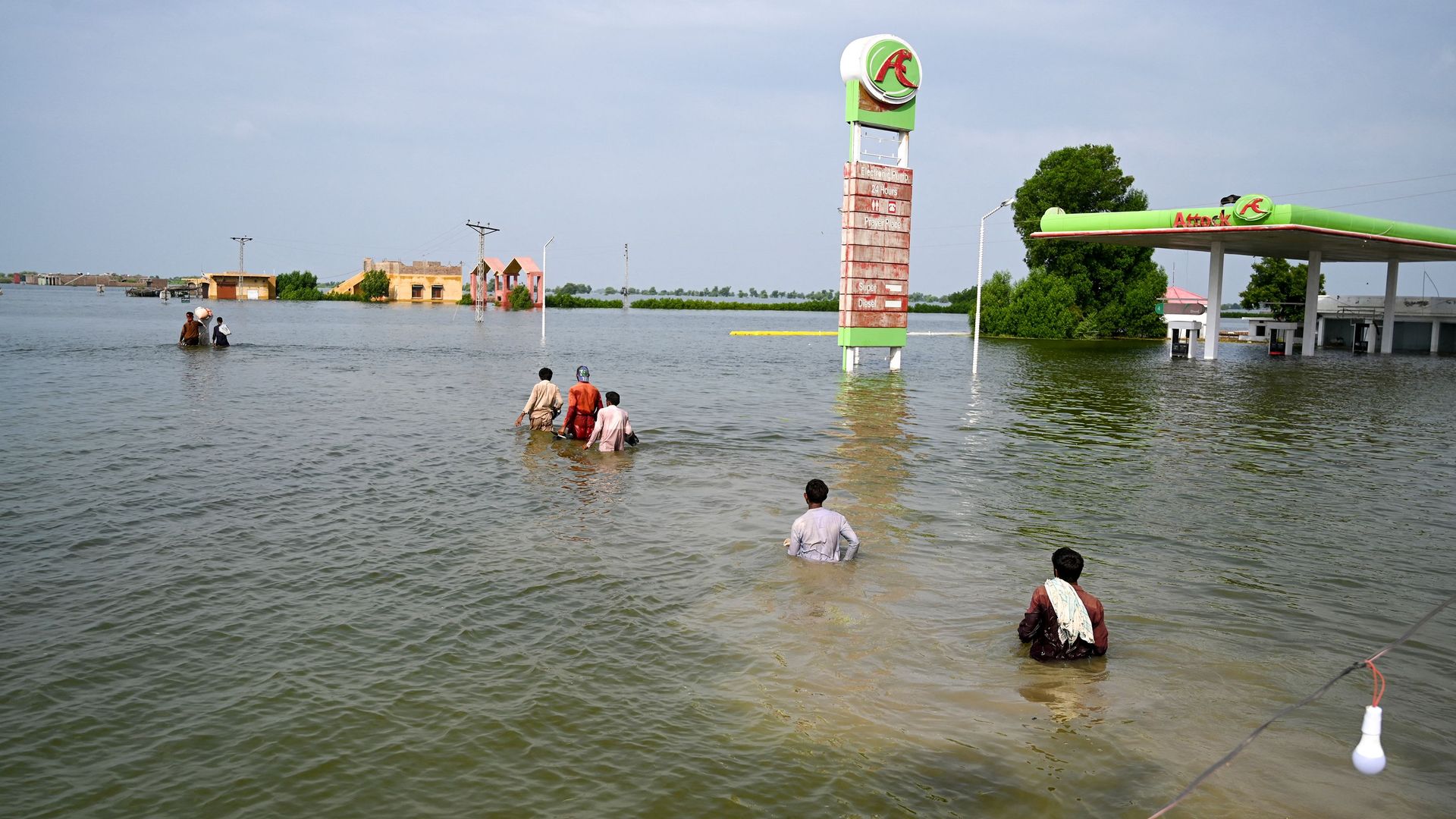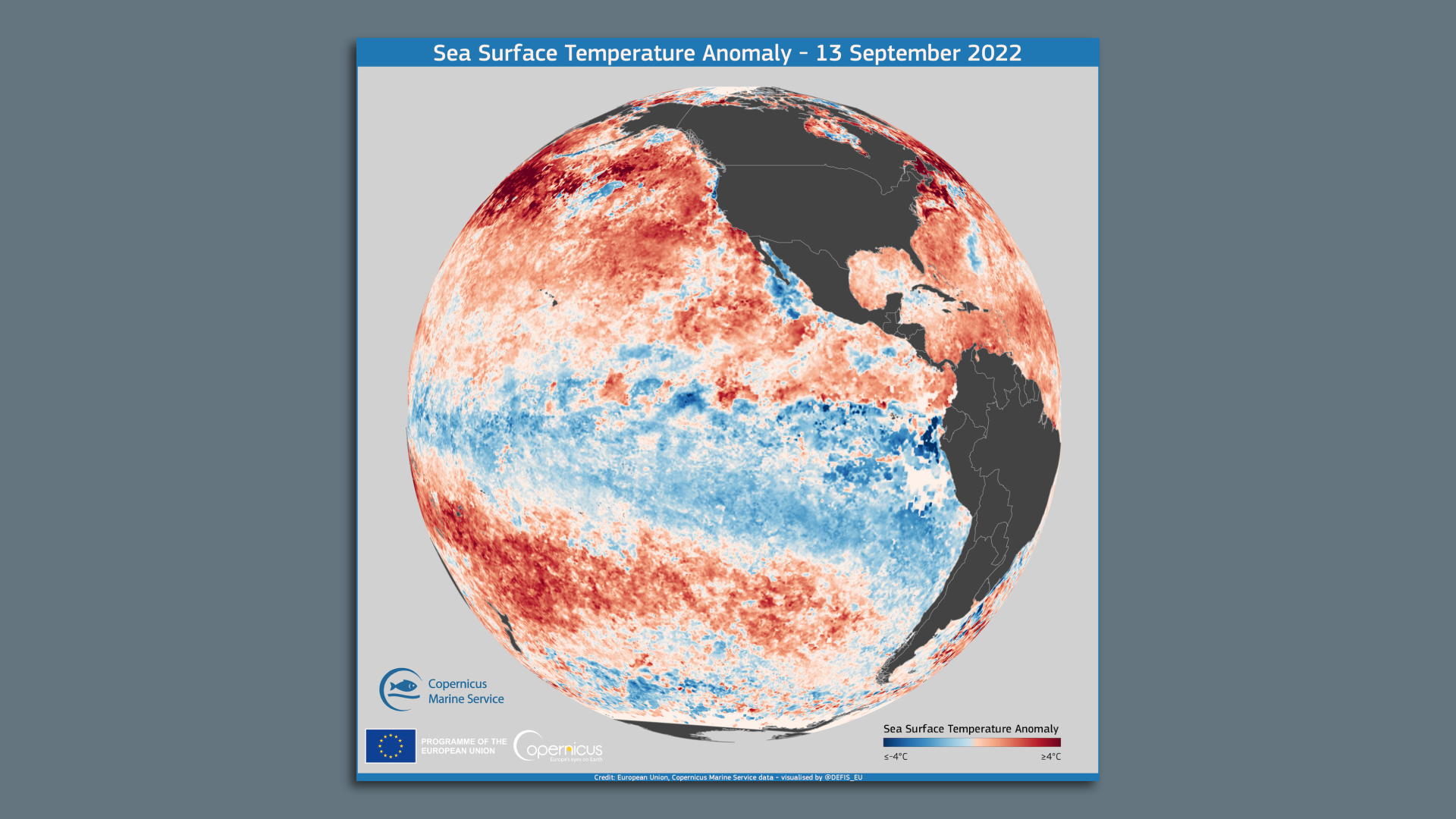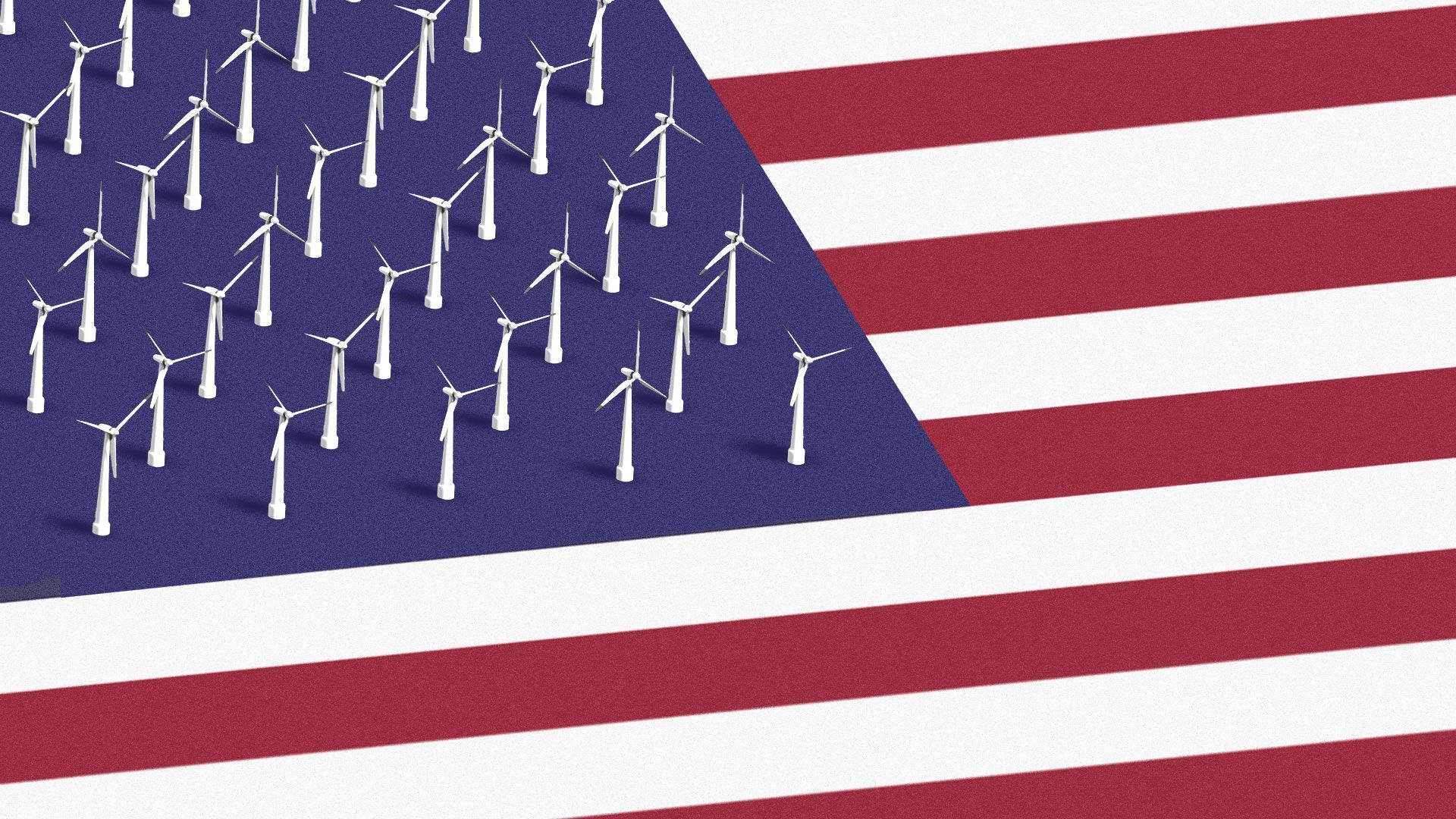| | | | | | | Presented By League of Conservation Voters | | | | Axios Generate | | By Ben Geman and Andrew Freedman · Sep 16, 2022 | | 🍺 Yes! Friday. Today's newsletter has a Smart Brevity count of 1,306 words, 5 minutes. 🗓️ Join Axios in Houston, Texas, at 8am CT Tuesday for the launch of the Axios Houston newsletter with an event focused on city sustainability efforts. Register to attend in person or virtually. 🎸 Happy birthday to the late blues legend B.B. King, who has this week's final intro tune... | | | | | | 1 big thing: Supercharged rains in Pakistan |  | | | People wade through floodwaters to return home after heavy monsoon rains in Dadu district, Sindh province, Pakistan on Sept. 7. Photo: Aamir Qureshi/AFP via Getty Images | | | | A new study shows the connections between the deadly, vast flooding in Pakistan and climate change, Andrew writes. The big picture: The study, released yesterday, shows that human-caused global warming may have boosted peak five-day rainfall amounts in the hardest-hit areas of Pakistan by up to 50%. - This means that without human-caused global warming one-third of the rains that fell would not have occurred, researchers told reporters.
- The study notes uncertainties regarding how climate change affects monsoonal rainfall in Pakistan, and the paucity of historical rainfall data there.
- Still, some climate models showed that nearly the entirety of the 50% precipitation increase could be attributed to climate change, the study shows.
- "An up to 50% or 75% increase in intensity of rainfall is huge and especially in a region that is very vulnerable," lead author Friederike Otto told reporters.
Context: Large swaths of Pakistan are still underwater from record monsoon rains, which have killed nearly 1,500 people and affected 33 million. - The Pakistan floods are visible via Earth-observing satellites, with lakes appearing where dry land had been, after the Indus River overflowed its banks, and broke through dams and other flood control structures.
- Pakistan's government has blamed the disaster on climate change, a claim the study's authors said has merit.
Zoom in: The new analysis comes from 26 members of the World Weather Attribution group, which is a loose-knit team of researchers that examines climate change's potential role in extreme events. - They studied the intensity of Pakistan's rainfall and simulated its occurrence with and without currently elevated levels of greenhouse gases in the atmosphere.
- The researchers focused specifically on a five-day period of the most torrential rains in the southern provinces of Sindh and Balochistan.
- Both provinces had their wettest Augusts on record, with seven to eight times their typical monthly totals.
Yes, but: Climate change, though important, was probably not the biggest factor in this disaster, the study's authors cautioned. - Natural disasters result from a combination of a hazard, in this case, heavy rains, interacting with vulnerability.
- And Pakistan had an excess of both.
- The highly vulnerable population played a major role, said coauthor Ayesha Siddiqi of the University of Cambridge, citing poverty rates, an unstable government, and a lack of an effective early warning weather system.
|     | | | | | | Bonus: La Niña's role in Pakistan's floods |  | | | Sea surface temperature anomalies in the tropical Pacific, show telltale signs of La Niña. (European Union, Copernicus Marine Environment Monitoring Service data) | | | | La Niña conditions in the tropical Pacific also raised the odds of heavy rains in Pakistan, according to study coauthor Fahad Saeed, Andrew writes. The big picture: La Niña features cooler than average ocean temperatures in the tropical Pacific. - Through associated changes in atmospheric circulation, it can influence a certain weather pattern in the Indian Ocean, known as the Indian Ocean Dipole.
- When the Dipole is negative as it is now, there are warmer than average waters in the eastern Indian Ocean. This can boost the moisture available for the South Asian monsoon, Saeed said.
|     | | | | | | 2. First look: Groups unveil climate law ad push |  | | | Illustration: Sarah Grillo/Axios | | | | Climate and progressive groups are launching a $10 million, 12-week ad campaign touting the new energy law, an effort targeted at young people and communities of color, Ben reports exclusively. Driving the news: The ads begin Monday on streaming services and social media platforms in states including Arizona, Michigan, Georgia, Nevada, Pennsylvania and a few others. - They're designed to "educate voters" about the law's benefits, per the rollout from Climate Power, the League of Conservation Voters, Black Progressive Action Coalition (BPAC), Somos Votantes and the NRDC Action Fund.
- "Communities of color have often been left out of conversations about combating climate change, the good jobs created as a means of protecting our natural resources, and decreasing energy costs," BPAC head Adrianne Shropshire said in a statement.
🔍 Zoom in: The first three spots are called "Swipe," "Solve It," and "The Facts." Why it matters: The campaign — which also includes in-state events Climate Power will host — is part of much wider moves by various climate advocates to promote the law's energy and climate provisions. There's a flurry of election-season activity and the new ads kick off what the groups call a multiyear push. The big picture: Several states in the buy are midterm battlegrounds. But a Climate Power spokesperson said locations were chosen for reasons including... - They're home to growing clean energy sectors.
- The regions are getting hit by climate change including extreme heat and floods.
- They've been sites of misinformation campaigns, including efforts targeting BIPOC communities.
|     | | | | | | A message from League of Conservation Voters | | President Biden just delivered a huge climate victory | | |  | | | | Now it's time to move forward with a supercharged transition to clean energy. ConocoPhillips' dirty and dangerous Willow project in America's Arctic threatens to take us backward. President Biden needs to say no to Willow and keep moving us forward. Learn more. | | | | | | 3. Almost every big company has climate risk |  | | | Illustration: Aïda Amer/Axios | | | | A new dataset zooms in on something increasingly clear in broad strokes to policymakers and many companies: Climate change is a business risk, Ben writes. Why it matters: Some 92% of the world's largest companies will have at least one asset at "high exposure" to climate-related physical risks by the 2050s, per S&P Global Sustainable1. - That's among the findings from its new Physical Risk Exposure Scores and Financial Impact tool.
- Another one: Over a third of the largest companies — as defined under S&P 's Global 1200 index — have at least one asset in which physical risks are equivalent to 20% or more of that asset's value.
Zoom in: The wider dataset and tool analyzes exposure to climate hazards for over 20,000 companies and over 870,000 asset locations based on various emissions scenarios, S&P said. It's a commercial product aimed at clients in the corporate and investment spaces seeking to understand their own exposures and risks to their portfolios. Bloomberg has more. |     | | | | | | 4. The latest White House offshore wind push |  | | | Illustration: Lazaro Gamio/Axios | | | | The Biden administration is expanding its offshore wind goals with steps aimed at developing floating projects in waters too deep for fixed-bottom installations, Ben writes. Driving the news: Officials yesterday announced a target of deploying 15 gigawatts worth of floating power capacity by 2035, which they call enough to power over 5 million homes. It adds to the existing target of 30 GW of offshore wind deployed by 2030. The big picture: Officials say deep waters off the West Coast, as well as the Gulf of Maine, have good potential for floating tech. - Thus far, just 0.1 gigawatts of floating offshore wind has been deployed globally, the White House said.
- The Interior Department is planning a deep-water auction off California's coast by the end of 2022.
Zoom in: New policies include adding floating offshore wind to the Energy Department's "Earthshot" programs that seek to cut tech costs. - The target for floating offshore wind is to cut costs by 70% to $45 per megawatt-hour by 2035.
- The administration is also funding analysis of port and transmission upgrades needed to support floating projects.
Zoom out: Offshore wind is a nascent industry in the U.S. But deep-pocketed companies like Shell, Equinor and Iberdrola are moving ahead with fixed-bottom, commercial-scale projects off the East Coast. |     | | | | | | 5. 🏃🏽♀️Catch up fast on policy: SEC and GHGs | | Senate Republicans bashed brewing SEC emissions disclosure mandates at a hearing yesterday that highlights the wider political battles over financial regulators' expanding climate change, Ben writes. Driving the news: Sen. Pat Toomey, the top Republican on the Banking Committee, told SEC chairman Gary Gensler that the rules are outside the regulators' mandate, will burden companies, and won't help investors. "But, of course, the climate disclosure isn't really about informed investment decisions. It's about equipping climate activists with data to run political pressure campaigns against companies, which will often be to the detriment of shareholders," Toomey said. What we're watching: Look for intensifying focus on the SEC and other regulators' climate work if the GOP wins one or both chambers in the midterms. 👀 Speaking of the Senate, Majority Leader Chuck Schumer yesterday announced a vote in the coming days on U.S. ratification of an amendment to a key environmental treaty. - The move under the Montreal Protocol would phase out hydrofluorocarbons (HFCs), a powerful planet-warming gas used in air conditioning and refrigeration.
- The 1987 treaty curbed substances that deplete the ozone layer, but one side effect was boosting HFC deployment.
- Ratifying the amendment would formalize the U.S. commitment to abandon HFCs, even though a law enacted in 2020 already requires steep domestic cuts.
|     | | | | | | A message from League of Conservation Voters | | President Biden just delivered a huge climate victory | | |  | | | | Now it's time to move forward with a supercharged transition to clean energy. ConocoPhillips' dirty and dangerous Willow project in America's Arctic threatens to take us backward. President Biden needs to say no to Willow and keep moving us forward. Learn more. | | | | 📬 Did a friend send you this newsletter? Welcome, please sign up. 🙏Thanks to Mickey Meece and David Nather for edits to today's newsletter. Have a great weekend and we'll see you back here on Monday. |  | | Why stop here? Let's go Pro. | | | | | | Axios thanks our partners for supporting our newsletters. If you're interested in advertising, learn more here.
Sponsorship has no influence on editorial content. Axios, 3100 Clarendon Blvd, Arlington VA 22201 | | | You received this email because you signed up for newsletters from Axios.
Change your preferences or unsubscribe here. | | | Was this email forwarded to you?
Sign up now to get Axios in your inbox. | | | | Follow Axios on social media:    | | | | | |









No comments:
Post a Comment